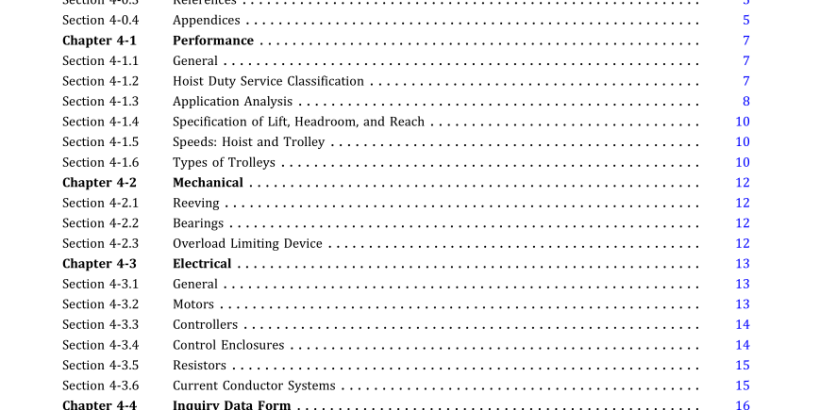ASME HST-4-2021 pdf free download.Performance Standard for Overhead Electric Wire Rope Hoists
SECTION 4-1.1: GENERAL All equipment selected in accordance with this Standard is designed to perform satisfactorily when installed, inspected, tested, operated, and maintained in accordance with ASME B30.16, Chapters 16-1 through 16-4 and used within the rated load and hoist duty service classification. All equipment shall provide speeds, lifts, and headroom in accordance with the manufacturer’s specifications, or to specifications agreed upon by the manufacturer and user.
SECTION 4-1.2: HOIST DUTY SERVICE CLASSIFICATION 4-1.2.1 General Considerations Service conditions infuence the performance of wearing parts of a hoist such as gears, bearings, rope, sheaves, elec- trical equipment, brake linings, load- and lift-limit devices, and wheels. Careful consideration of the hoist duty service classifications described in this Section will enable the user to evaluate the application and to obtain a hoist designed for optimum performance and minimum maintenance. If doubt exists regarding hoist selection, the hoist supplier should be consulted. Many factors enter into the selection of the proper hoist to perform a given function. Hoisting equipment consists of both mechanical and electrical components, and both must be considered when analyzing the service that the hoist must perform. The factors that influence the performance of any hoist include the following:
(a) Load Distribution. The actual distribution or proportion of full and partial loads to be handled by the equipment, including lifting devices, has an important effect on the life of power transmission components. For example, ball bearing life generally varies inversely according to the cube of the load. A 2-ton (1 814.4-kg) hoist, operated at a mean effective load of 1 ton (907.2 kg), will have a ball bearing life eight times that of the same hoist used steadily at its rated load.
(b) Operational Time. Operational time is the total running time of the hoist per hour or work period.
(c) Work Distribution. This is determined by whether the operational time is uniformly distributed over the work period or concentrated in a short time span. Work distribution generally does not appreciably affect mechanical wear but does materially affect the electrical components such as motors, brakes, and controls. For example, a hoist motor designed to operate 15 min out of each hour of an 8-hr shift cannot handle 2 hr of steady run and 6 hr of idle time even though both conditions require 2 hr of operational time per 8-hr shift.
(d) Number ofStarts and Stops. This directly affects all electromechanical devices, such as motors, contactors, brakes, and solenoids.
(e) Repetitive Long Lowering Operations. Such operations generate heat in control braking means. 0) Environmental Conditions. Such conditions include ambient temperature and the presence of dust, moisture, corro- sive fumes, etc. Hoist equipment is designed to operate in ambient temperatures between 0°F and 1049F(-18°C and 40°C) and in atmospheres reasonably free from dust, moisture, and corrosive fumes unless otherwise specified.
4-1.2.2 Hazardous Locations When hoists are used in hazardous locations as defined by ANSI/NFPA 70 or other special codes, modifications, or additional precautions not covered by this Standard may be required. In these locations, only hoists designed in a manner suitable for the conditions encountered shall be used. Nonmandatory Appendix C provides guidance for both the manu- facturer and the end user to assist in configuring a hoist to make it suitable for use in a potentially explosive environment.
4-1.2.3 Duty Classification All the factors listed in para. 4-1.2.1 must be considered in selecting the proper class of hoist. However, most industrial applications, having randomly distributed loads or uniform loads up to 65% of rated load handled periodically throughout the work period, can be generalized according to the type of workshop or area of application.ASME HST-4 pdf download.ASME HST-4-2021 pdf free download
